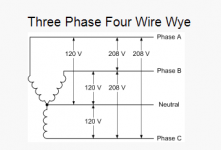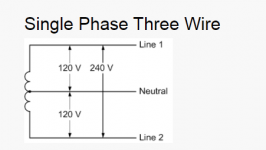That I agree with..................I think 480 is twice 240. Again, math is hard.
You are using an out of date browser. It may not display this or other websites correctly.
You should upgrade or use an alternative browser.
You should upgrade or use an alternative browser.
Single Ph. 208 /120 Transformer One-Line diagram--stuck on details
- Thread starter Installer
- Start date
- Status
- Not open for further replies.
230V is live and neutral. 400V is generally 3-phase.Certainly within each wye system, the L-L voltage is 1.732 times the L-N voltage. That's expressed in the nomenclature 415Y/240, that means a wye system with 415V L-L and 240V L-N.
So the UK has 415Y/240 (as I understand it, or 400Y/230 nominal for EU harmonization). The US has 208Y/120. The US system is half the voltage of the UK system, for L-L or L-N or any corresponding measurement.
Now how about my question, is it common to have 2-wire 415V (or 400V) loads in UK/Europe? Here it is not uncommon to have loads that are designed for 2-wire 208V, which can be run L-L on a 208Y/120 system.
Cheers, Wayne
wwhitney
Senior Member
- Location
- Berkeley, CA
- Occupation
- Retired
Glad we can agree on that.230V is live and neutral. 400V is generally 3-phase.
So in the UK, if a building is supplied with 400V 3-phase power, does the supply typically have a neutral as well? Allowing the use of 230V 2-wire loads, from L-N?
Second question, when 400V 3-phase power is available, how common is it to have a 2-wire load that works on 400V, supplied L-L?
Cheers, Wayne
petersonra
Senior Member
- Location
- Northern illinois
- Occupation
- engineer
Here is a diagram of US 208/120 wye systems.

European 400/230 V (aka 415/240 or 380/220) systems are the same except for the voltage.
Sometimes we just use two of the 208 V lines and a neutral to feed a dwelling. Sometimes this is done in commercial or industrial facilities as well because 240/120 panelboards are cheaper than 3 phase 208/120 panelboards.
Diagram of US 240/120 system.


European 400/230 V (aka 415/240 or 380/220) systems are the same except for the voltage.
Sometimes we just use two of the 208 V lines and a neutral to feed a dwelling. Sometimes this is done in commercial or industrial facilities as well because 240/120 panelboards are cheaper than 3 phase 208/120 panelboards.
Diagram of US 240/120 system.

Good!Glad we can agree on that.
So in the UK, if a building is supplied with 400V 3-phase power, does the supply typically have a neutral as well? Allowing the use of 230V 2-wire loads, from L-N?
Second question, when 400V 3-phase power is available, how common is it to have a 2-wire load that works on 400V, supplied L-L?
Cheers, Wayne
For residential the supply is 230V. For commercial it is usually 400V with a neutral. In our building much the equipment was 230V for lighting and similar. We manufactured variable speed drives and these were 400V units. There were some specials for 3.3kV. and 11kV.
I don't recall 2-wire loads. Just single phase or 3-wire.
Hope that helps.
majik009
Member
- Location
- Massachusetts
- Occupation
- Electrical Contractor
Source to xformer = 950' ...if I'm seeing that correctly ?
oldsparky52
Senior Member
- Location
- Wilmington, NC USA
Isn't a single-phase load a 2-wire load?I don't recall 2-wire loads. Just single phase or 3-wire.
Aren't all 2-wire loads single-phase?
Called live and neutral in my neck of the woods.Isn't a single-phase load a 2-wire load?
Aren't all 2-wire loads single-phase?
wwhitney
Senior Member
- Location
- Berkeley, CA
- Occupation
- Retired
You never have 2-wire live-live loads?Called live and neutral in my neck of the woods.
Cheers, Wayne
Well, I didn't. We had live and neutral 230V and 400V 3-phase. I can't for certainty that no one did. But my background was/is industrial power electronics so we didn't have live-live.You never have 2-wire live-live loads?
Cheers, Wayne
kwired
Electron manager
- Location
- NE Nebraska
And if you connected something between only two of the ungrounded lines it is still a single phase load but with 400 volts applied.It is just single phase for 230V. Not single phase.
Though it sounds like you seldom if ever have any equipment that is designed for 400 volts single phase supply.
We seem to love having a big variety of voltage options over this side of the pond. There is commonly single phase loads that operate on 120, 208, 240, 277 and 480 over here, some equipment even has input taps to operate on two, three, even all five of those choices.
ETA: should have read all the posts, this kind of already been answered
Last edited:
kwired
Electron manager
- Location
- NE Nebraska
He never said 240Y he said 208/120 is half of 215/240 (really should have said 216/240, but then multiply or divide any whole number by square root of three and you not very likely to have a whole number result...I think 120 is twice 240.
But 240Y is NOT 415V
kwired
Electron manager
- Location
- NE Nebraska
Is what is at the load end of the 950 foot run still in same building? You may actually have more options if it is a separate building/structure than if it is in same building.Thank you INFINITY. I don't know transformers that well.
What am I missing?
1. Please remember I am stuck with 2 Hots and 1 Neutral conductor because its a direct bury under a busy area.
2. The Neutral is coming from the Neutral bus that is bonded to the Ground bus at the Panel.
3. I tied the Neutral to the Ground at the Counterpoise at the Site. (red circle)
4. What am I missing?
Thanks for your help View attachment 2557349
Since your neutral is 6 AWG, you can't per NEC just put green tape on it and call it an EGC, if it were 4 AWG or larger you could.
wwhitney
Senior Member
- Location
- Berkeley, CA
- Occupation
- Retired
415.0 / sqrt(3) = 240.208/120 is half of 415/240 (really should have said 416/240, but then multiply or divide any whole number by square root of three and you not very likely to have a whole number result...
240.0 * sqrt(3) = 416
Is there an applicable standard which defines whether the nominal system is defined in term an integral L-L voltage or an integral L-N voltage?
Cheers, Wayne
kwired
Electron manager
- Location
- NE Nebraska
Rounded results. Get enough places to the right of the decimal (in all the figures used) and the results get closer to one another.415.0 / sqrt(3) = 240.
240.0 * sqrt(3) = 416
Is there an applicable standard which defines whether the nominal system is defined in term an integral L-L voltage or an integral L-N voltage?
Cheers, Wayne
wwhitney
Senior Member
- Location
- Berkeley, CA
- Occupation
- Retired
Correct, that's my point.Rounded results. Get enough places to the right of the decimal (in all the figures used) and the results get closer to one another.
So your saying that it should be 416/240 instead of 415/240 is equivalent to saying that the L-N voltage is the starting number, with L-L voltage derived by multiplying by sqrt(3). As opposed to the L-L voltage being the starting number, with the L-N voltage derived by dividing by sqrt(3) (in which case both 415/240 and 416/240 are valid options).
Cheers, Wayne
kwired
Electron manager
- Location
- NE Nebraska
True.Correct, that's my point.
So your saying that it should be 416/240 instead of 415/240 is equivalent to saying that the L-N voltage is the starting number, with L-L voltage derived by multiplying by sqrt(3). As opposed to the L-L voltage being the starting number, with the L-N voltage derived by dividing by sqrt(3) (in which case both 415/240 and 416/240 are valid options).
Cheers, Wayne
This all started with a reply to "But it isn't isn't half the voltage of the 415V - 240V"
Half of 240 is 120, half of 415 is 207.5.
If you double 208/120 you have 416/240.
That is why I put in the 416.
kwired
Electron manager
- Location
- NE Nebraska
Bottom line, all wye systems have line to line voltage that is square root of 3 times higher than line to neutral voltage.UK and other European countries are 400V/230V. Nominally.
In North America we just happen to have many different voltages present in the systems we do have and somewhere someone is making equipment that will connect to any of those possible voltages where much the rest of the world they only use 230 volt if single phase equipment and 400 volts if it is three phase equipment.
Frank DuVal
Senior Member
- Occupation
- Electrical Contractor, Electrical Engineer
Absolutely you DO!Except it isn't. There is no 120-0-120 for a start, We have 0-230V. And no 208V or similar.
You have a three phase Y system, just the voltages are higher than we use here in the US and Canada, or lower (as in 277/480 Y or 347/600 systems).
Ignore the "We do not have 120, etc.".
You have 230 from phase to neutral and 400 between phases, right? What you are missing is a whole selection of appliances and other large loads for sale at the local store that use single phase 400. If you needed to wire a 400 volt single phase stove (range, cooktop, dryer) you would put each wire to a phase. Simple. That's what we do with large appliances, put them on two phases to get SINGLE PHASE! It is one sinewave. Therefore single phase.
Our three phase system follows the same physics rules that your three phases do.
- Status
- Not open for further replies.
